WR1 Module Datasheet
Last Updated on : 2024-08-19 02:35:39download
The WR1 is a low-power embedded Wi-Fi module developed by Hangzhou Tuya Information Technology Co., Ltd. The module consists of a highly integrated RTL8710BN chip and external flash memory. It comes with a built-in Wi-Fi network protocol and a large number of library functions.
Overview
The WR1 also includes low power ARM CM4F, WLAN MAC, 1T1R WLAN, a maximum frequency of 125MHz, built-in 256K SRAM, 1Mbyte flash, and a wealth of peripheral resources.
The WR1 is an RTOS platform that gathers all Wi-Fi MAC and TCP/IP libraries into one place. It enables users to build on the product and develop embedded Wi-Fi products that suit their individual needs.
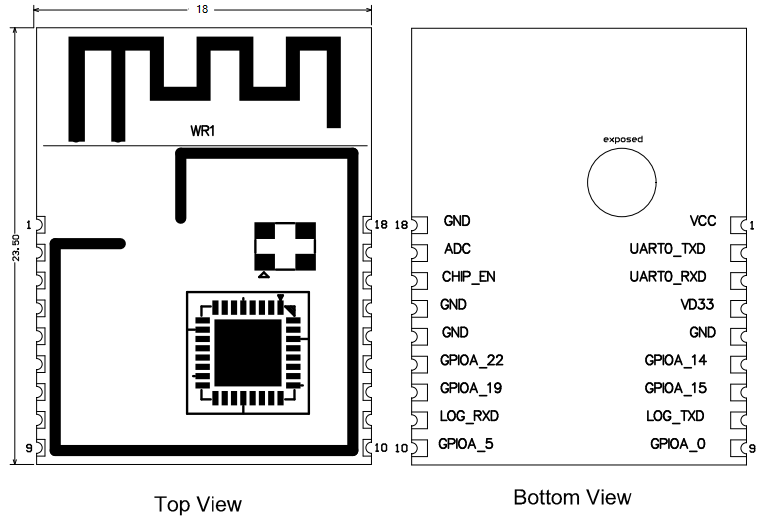
Features
- A built-in low-power 32-bit CPU that doubles as an application processor.
- Main frequency 125MHz
- Operating voltage: 3V-3.6V
- Peripherals: 6xGPIOs, 2xUARTs, 1xADC
- Wi-Fi connectivity:
- 802.11 B/G/N20/N40
- Channels 1-14@2.4GHz
- Supports WEP/WPA/WPA2/WPA2 PSK (AES) security modes
- +20dBm output in 802.11b mode
- Supports SmartConfig (for both Android and iOS devices)
- An onboard PCB antenna and an external antenna IPEX connector
- CE, FCC, SRRC certified
- Operating temperature: -20℃ to 85℃
Primary application field
- Smart buildings
- Smart homes/appliances
- Medical and health
- Industrial wireless control
- Baby monitors
- Webcams
- Smart public transportation
Module interfaces
Package dimensions
The WR1 has 2 rows of pins (2x9) with a 1.5mm gap.
WR1 dimensions: 18 mm (W) x 23.5 mm (L) x 3.3 mm (H); package as shown in the following figure:
WR1 dimensional drawing:
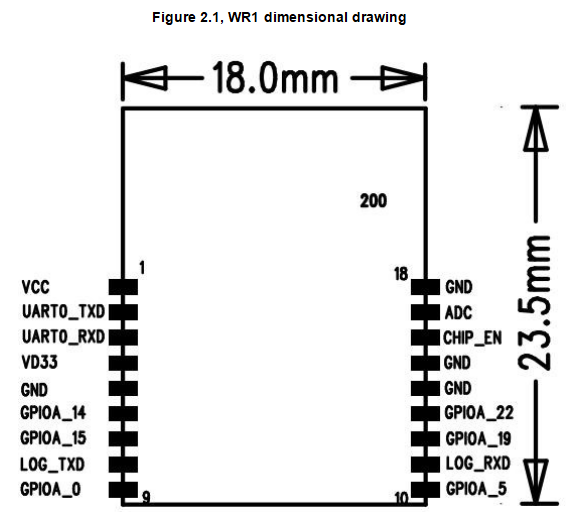
Pin definition
Conventional pins are defined as shown in the following table:
WR1 pins description:
| Pin | Symbol | I/O type | Function |
|---|---|---|---|
| 1 | VCC | P | UART0_TXD power conversion (5V or 3.3V) |
| 2 | UART0_TXD | I/O | UART0_TXD (user serial port) |
| 3 | UART0_RXD | I/O | UART0_RXD (user serial port) |
| 4 | VD33 | P | Module power supply pin (3.3V) |
| 5 | GND | P | Ground plane |
| 6 | GPIOA_14 | I/O | GPIOA_14 |
| 7 | GPIOA_15 | I/O | GPIOA_15 |
| 8 | LOG_TXD | I/O | UART_Log_TXD (for printing internal information of the module) |
| 9 | GPIOA_0 | I/O | GPIOA_0, can not be HIGH at the moment it is powered on, but can be after powering onConfiguration |
| 10 | GPIOA_5 | I/O | GPIOA_5 |
| 11 | LOG_RXD | I/O | UART_Log_RXD (for printing internal information of the module) |
| 12 | GPIOA_19 | I/O | GPIOA_19 |
| 13 | GPIOA_22 | I/O | GPIOA_22 |
| 14 | GND | P | Ground plane |
| 15 | GND | P | Ground plane |
| 16 | CHIP_EN | I/O | The pin function is disabled by firmware, user can choose not to connect. |
| 17 | ADC | AI | ADC port, maximum input voltage 5V |
| 18 | GND | P | Ground plane |
Note:
Pindicates the power pin, I/O indicates the input/output pin, and AI indicates the analog input pin.
Electrical Parameters
Absolute electrical parameters
Absolute Parameters:
| Parameters | Description | Minimum value | Maximum value | Unit |
|---|---|---|---|---|
| Ts | Storage temperature | -40 | 105 | ℃ |
| VDD | Input voltage | -0.3 | 3.6 | V |
| Electrostatic discharge voltage (human-body model) | TAMB-25℃ | - | 2 | KV |
| Electrostatic discharge voltage (machine model) | TAMB-25℃ | - | 0.5 | KV |
Operating conditions
Normal operating conditions:
| Parameters | Description | Min | Typ | Max | Unit |
|---|---|---|---|---|---|
| Ta | Operating temperature | -20 | - | 85 | ℃ |
| VDD | Operating voltage | 3.0 | - | 3.6 | V |
| VIL | IO low input | -0.3 | - | VDD*0.25 | V |
| VIH | IO high input | VDD*0.75 | - | 3.6 | V |
| VOL | IO low output | - | - | VDD*0.1 | V |
| VOH | IO high output | VDD*0.8 | - | VDD | V |
| Imax | IO drive current | - | - | 16 | mA |
| Cpad | Input pin capacitance | - | 2 | - | pF |
Wi-Fi TX power consumption
Power consumption during continuous TX:
| Symbol | Mode | Power | Typ | Unit |
|---|---|---|---|---|
| IRF | 11b11Mbps | 17dBm | 287 | mA |
| IRF | 11b11Mbps | 18dBm | 295 | mA |
| IRF | 11g54Mbps | 15dBm | 255 | mA |
| IRF | 11g54Mbps | 17.5dBm | 267 | mA |
| IRF | 11n BW20MCS7 | 13dBm | 244 | mA |
| IRF | 11n BW20MCS7 | 16.5dBm | 257 | mA |
| IRF | 11n BW40MCS7 | 13dBm | 220 | mA |
| IRF | 11n BW40MCS7 | 16.5dBm | 230 | mA |
Wi-Fi RX power consumption
Power consumption during continuous RX:
| Symbol | Mode | Typ | Unit |
|---|---|---|---|
| IRF | CPU sleep | 90 | mA |
| IRF | CPU active | 120 | mA |
Power consumption in operating mode
Module operating current:
| Operation Mode | Operating condition, TA=25℃ | Typ | Peak* | Unit |
|---|---|---|---|---|
| Quick configuration | Module in the quick net-pairing state, Wi-Fi indicator blinking | 115 | 130 | mA |
| Network connection idle | Module connected to the network, Wi-Fi indicator constantly on | 50 | 110 | mA |
| Network connection active | Module connected to the network, Wi-Fi indicator constantly on | 120 | 265 | mA |
| Disconnected | Module not connected to the network, Wi-Fi indicator always off | 35 | 90 | mA |
Note: The peak period is approximately 5μs.
The parameters above may vary according to the firmware.
RF Characteristics
Basic RF characteristics
Basic RF characteristics:
| Parameter | Description |
|---|---|
| Frequency range | 2.400 to 2.4835GHz |
| Wi-Fi standard | IEEE 802.11b/g/n (channels 1-14) |
| Data transfer rate |
|
| Antenna type | PCB antenna (default)U.FL RF connector external antenna (optional) |
Wi-Fi output power
Continuous TX Power:
| Parameter | Minimum value | Typical value | Maximum value | Unit | |
|---|---|---|---|---|---|
| RF average output power, 802.11b CCK Mode | 11M | - | 17.5 | - | dBm |
| RF average output power, 802.11g OFDM Mode | 54M | - | 14.5 | - | dBm |
| RF average output power, 802.11n OFDM Mode | MCS7 | - | 13.5 | - | dBm |
| Frequency error | -10 | - | 10 | ppm |
Wi-Fi RX sensitivity
RX Sensitivity:
| Parameter | Min | Typ | Max | Unit | |
|---|---|---|---|---|---|
| PER<8%, RX sensitivity, 802.11b CCK Mode | 11M | - | -91 | - | dBm |
| PER<10%, RX sensitivity, 802.11g OFDM Mode | 54M | - | -75 | - | dBm |
| PER<10%, RX sensitivity, 802.11n OFDM Mode | MCS7 | - | -72 | - | dBm |
Antenna Signal
Antenna type
There are two antenna access modes: PCB onboard antenna and external antenna. The default method is PCB onboard antenna.

Antenna interference reduction
To optimize the performance of the Wi-Fi module in combination with the PCB onboard antenna, it is recommended to keep the antenna at least 15mm from other metal parts.
U.FL RF connector
U.FL RF connector parameters are shown in the figure below:
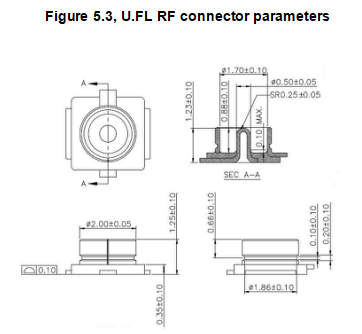
Packaging information and production guidance
Mechanical dimensions
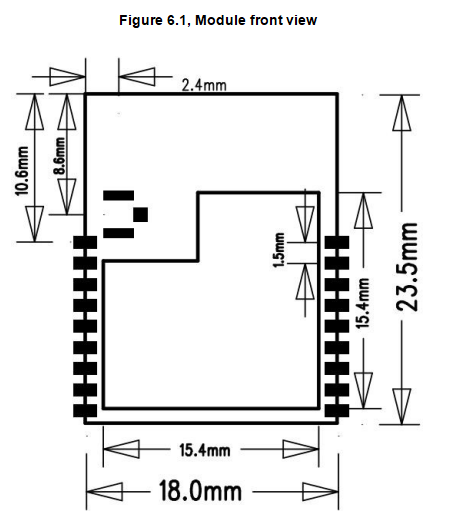

Note: The PCB frame tolerance is ±0.35mm and the PCB thickness tolerance is ±0.1mm.
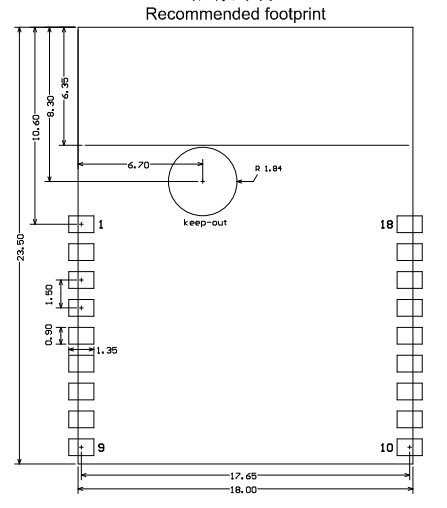
Production instructions
-
The Tuya SMT module should be mounted by the SMT device. After being unpacked, it should be soldered within 24 hours. Otherwise, it should be put into the drying cupboard where the RH is not greater than 10%; or it needs to be packaged under vacuum again and the exposure time needs to be recorded (the total exposure time cannot exceed 168 hours).
- SMT devices:
- Mounter
- SPI
- Reflow soldering machine
- Thermal profiler
- Automated optical inspection (AOI) equipment
- Baking devices:
- Cabinet oven
- Anti-electrostatic and heat-resistant trays
- Anti-electrostatic and heat-resistant gloves
- SMT devices:
-
Storage conditions for a delivered module:
-
The moisture-proof bag must be placed in an environment where the temperature is below 40°C and the relative humidity is lower than 90%.
-
The shelf life of a dry-packaged product is 12 months from the date when the product is packaged and sealed.
-
There is a humidity indicator card (HIC) in the packaging bag.
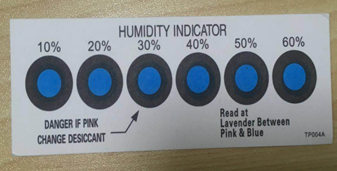
-
-
The module needs to be baked in the following cases:
- The packaging bag is damaged before unpacking.
- There is no HIC in the packaging bag.
- After unpacking, circles of 10% and above on the HIC become pink.
- The total exposure time has lasted for over 168 hours since unpacking.
- More than 12 months have passed since the sealing of the bag.
-
Baking settings:
- Temperature: 40°C and ≤ 5% RH for reel package and 125°C and ≤5% RH for tray package (please use the heat-resistant tray rather than a plastic container)
- Time: 168 hours for reel package and 12 hours for tray package
- Alarm temperature: 50°C for reel package and 135°C for tray package
- Production-ready temperature after natural cooling: < 36°C
- Re-baking situation: If a module remains unused for over 168 hours after being baked, it needs to be baked again.
- If a batch of modules is not baked within 168 hours, do not use the wave soldering to solder them. Because these modules are Level-3 moisture-sensitive devices, they are very likely to get damp when exposed beyond the allowable time. In this case, if they are soldered at high temperatures, it may result in device failure or poor soldering.
-
In the whole production process, take electrostatic discharge (ESD) protective measures.
-
To guarantee the passing rate, it is recommended that you use the SPI and AOI to monitor the quality of solder paste printing and mounting.
Recommended oven temperature curve
Set oven temperatures according to the following temperature curve of reflow soldering. The peak temperature is 245°C.

-
A: Temperature axis
-
B: Time axis
-
C: Liquidus temperature: 217 to 220°C
-
D: Ramp-up slope: 1 to 3°C/s
-
E: Duration of constant temperature: 60 to 120s; the range of constant temperature: 150 to 200°C
-
F: Duration above the liquidus: 50 to 70s
-
G: Peak temperature: 235 to 245°C
-
H: Ramp-down slope: 1 to 4°C/s
Note: The above curve is just an example of the solder paste SAC305. For more details about other solder pastes, please refer to Recommended oven temperature curve in the solder paste specifications.
Storage conditions

MOQ and Packaging Information
| Product Number | MOQ (pcs) | Shipping packaging method | Number of modules per reel (pcs) | Number of reels per carton (reel) |
|---|---|---|---|---|
| WR1 | 3600 | Tape reel | 900 | 4 |
Appendix: Statement
FCC Caution: Any changes or modifications not expressly approved by the party responsible for compliance could void the user’s authority to operate this device.
This device complies with Part 15 of the FCC Rules. Operation is subject to the following two conditions: (1) This device may not cause harmful interference, and (2) this device must accept any interference received, including interference that may cause undesired operation.
Note: This device has been tested and found to comply with the limits for a Class B digital device, according to part 15 of the FCC Rules. These limits are designed to provide reasonable protection against harmful interference in a residential installation. This device generates, uses, and can radiate radio frequency energy and, if not installed and used following the instructions, may cause harmful interference to radio communications. However, there is no guarantee that interference will not occur in a particular installation.
If this device does cause harmful interference to radio or television reception, which can be determined by turning the device off and on, the user is encouraged to try to correct the interference by one or more of the following measures:
- Reorient or relocate the receiving antenna.
- Increase the separation between the device and receiver.
- Connect the device to an outlet on a circuit different from that to which the receiver is connected.
- Consult the dealer or an experienced radio/TV technician for help.
Radiation Exposure Statement
This device complies with FCC radiation exposure limits set forth for an uncontrolled rolled environment. This device should be installed and operated with a minimum distance of 20cm between the radiator and your body.
Important Note
This radio module must not be installed to co-locate and operate simultaneously with other radios in the host system except following FCC multi-transmitter product procedures. Additional testing and device authorization may be required to operate simultaneously with other radios.
The availability of some specific channels and/or operational frequency bands are country dependent and are firmware programmed at the factory to match the intended destination. The firmware setting is not accessible by the end-user.
The host product manufacturer is responsible for compliance with any other FCC rules that apply to the host not covered by the modular transmitter grant of certification. The final host product still requires Part 15 Subpart B compliance testing with the modular transmitter installed.
The end-user manual shall include all required regulatory information/warnings as shown in this manual, including “This product must be installed and operated with a minimum distance of 20 cm between the radiator and user body”.
This device has got an FCC ID: 2ANDL-WR1. The end product must be labeled in a visible area with the following: “Contains Transmitter Module FCC ID: 2ANDL-WR1”.
This device is intended only for OEM integrators under the following conditions:
The antenna must be installed such that 20cm is maintained between the antenna and users, and the transmitter module may not be co-located with any other transmitter or antenna.
As long as the 2 conditions above are met, further transmitter tests will not be required. However, the OEM integrator is still responsible for testing their end-product for any additional compliance requirements required with this module installed.
Declaration of Conformity European Notice

Hereby, Hangzhou Tuya Information Technology Co., Ltd declares that this module product is in compliance with essential requirements and other relevant provisions of Directive 2014/53/EU,2011/65/EU. A copy of the Declaration of conformity can be found at https://www.tuya.com.

This product must not be disposed of as normal household waste, in accordance with the EU directive for waste electrical and electronic equipment (WEEE-2012/19/EU). Instead, it should be disposed of by returning it to the point of sale, or to a municipal recycling collection point.
The device could be used with a separation distance of 20cm to the human body.
Is this page helpful?
YesFeedbackIs this page helpful?
YesFeedback





